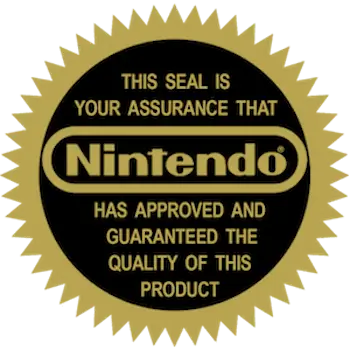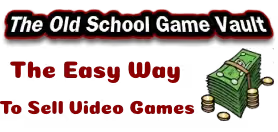The late 1970s saw the release of the Atari 2600 and the rise of the home gaming console. But by the early 1980s, the industry crashed and burned.
This collapse was fueled by gamer frustration with rushed, low-quality titles—just ask anyone who played “E.T. The Extra Terrestrial.” The disaster effectively killed consumer trust in home consoles.
Nintendo of America took this lesson seriously leading up to the 1985 launch of their NES home console. To win back gamers, Nintendo needed a way to assure customers that their products met strict quality standards.
The Table of Contents
Enter: The Nintendo Seal of Quality
These stickers became Nintendo’s promise of compatibility and quality. Over the years, both the seal designs and cartridge case designs changed. For example, the first release of “Metroid” came with a silver label, but the 1992 re-release swapped to yellow.
example, the first release of “Metroid” came with a silver label, but the 1992 re-release swapped to yellow.
That color shift may seem minor, but for collectors, it creates a resale value difference of $10 or more—depending on condition and market demand. For more on NES Seal history, check out the Nintendo Fandom Wiki on the Official Seal.
Same goes for The Legend of Zelda, first released in 1986 with its iconic gold cartridge. In 1992, Nintendo reissued the game with a standard gray shell—a detail collectors watch for. For more Zelda label info, check out our guide on Zelda games from the 1990s.
Why Collectors Obsess Over NES Label Variants
Retro gamers and collectors love spotting design changes Nintendo made over the years. One well-known shift happened around 1992 when Nintendo added a red strip label at the top of the box, while also removing the red line from cartridge tops.
If you’re into obscure production quirks, also check out our guide on NES-to-Famicom adapters.
Label Differences in Action: Punch-Out!! Example

Let’s look at Mike Tyson's Punch-Out vs regular Punch-Out. Both are technically the same game, but the label makes all the difference. Collectors pay special attention to which version they have—one features Mike Tyson himself, while the other replaces him with Mr. Dream after Nintendo’s license with Tyson expired.
- Nintendo paid Tyson $50,000 with no royalties.
- In hindsight, considering the franchise made an estimated 1.7 billion dollars, Nintendo got quite the deal.
- Once the license expired, Nintendo swapped out all references to Tyson—including the front label and the final boss character.
The Black/Gold Nintendo NES Seal
This was the original seal featured on early NES games (1985-1988). It symbolized Nintendo’s promise of authenticity and served as a visual stamp of quality control.
promise of authenticity and served as a visual stamp of quality control.
This seal was mostly cosmetic but made a huge impact on consumer trust during the fragile post-crash years.
The White/Gold Seal
In 1989, Nintendo redesigned the seal with a white and gold color scheme and simplified text: “Official Nintendo Seal of Quality.”
While the wording change made the seal easier to read, the focus shifted from gameplay quality to basic hardware compatibility.
Red-Top Labels: The Canadian Connection & Classic NES Series
If you’ve collected NES games for any length of time, you’ve likely seen “red-top” label variants—most famously on games like Hogan’s Alley. But what’s the story behind that bold red banner?
The answer isn’t as simple as “they’re Canadian.” While many red-label games were distributed in Canada, not all are exclusive to that region. In fact, Nintendo’s “Classic Series” reprints—released in the U.S. and Canada—also featured red-tinted packaging and updated branding to signal they were part of a legacy line.
So what’s the difference?
- Classic Series games (like Metroid or Kirby) often say “Classic Series” on the box or cart and were released in both the U.S. and Canada.
- Canadian-specific red label variants may include bilingual packaging, a “Nintendo of Canada Ltd.” sticker, or alternate artwork—but not always the Classic Series branding.

It’s a fun (and sometimes confusing) part of NES collecting. Red labels can signal a later reprint, a regional variant, or both—depending on the title. That mystery is part of what makes NES hunting so interesting.
The Modern Nintendo Seal
Today, Nintendo continues the seal tradition with an even more streamlined logo that simply says: “Official Nintendo Seal.”
The focus is now entirely on licensing—quality promises are no longer part of the seal’s messaging. If you’re curious about how the Nintendo Seal’s role has changed over the decades, check out this great analysis from Nintendo Life.
💰 Turn Your NES Games Into Cash!
Have NES cartridges you want to sell? From rare variants to common classics, we buy them all. Get a fast quote and hassle-free payout.
Frequently Asked Questions:
What does the Nintendo Seal of Quality mean?
- The Nintendo Seal of Quality was introduced to assure buyers that NES games met Nintendo's hardware compatibility and basic quality standards.
- The seal changed designs over the years but always served as a mark of authenticity.
How can I tell which NES seal variation my game has?
- Look at the color and wording on the seal. Early games (1985-1988) featured a black/gold seal with more text, while later releases (1989 onward) used a white/gold seal with simplified wording.
Why do some NES games have red-top labels?
- Red-top NES game labels typically indicate Canadian releases.
Where can I sell original NES games and cartridges?
- If you want to sell NES games, visit our NES selling page for fast cash offers and hassle-free payouts.








